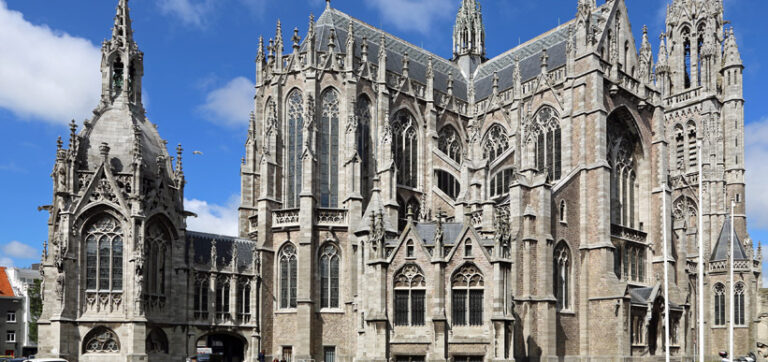What Are The Historical Influences On Gothic Architecture?
Gothic architecture is a style that originated during the medieval period in Europe, specifically in France, and it is characterized by pointed arches, ribbed vaults, and flying buttresses. The style flourished from the 12th to the 16th century and can still be seen in many buildings and cathedrals around the world.
If you are interested in Gothic architecture, here are some key characteristics that define the style:
1. Pointed Arches
One of the most prominent features of Gothic architecture is the use of pointed arches. These arches, which replaced the rounded arches of Romanesque architecture, make possible taller structures with wider windows and a more vertical appearance. Pointed arches were a significant innovation in architectural design and allowed for greater flexibility in design.
2. Ribbed Vaults
Gothic architecture is also characterized by the use of ribbed vaults. These vaults are formed by a series of arched masonry ribs that spring from the columns or piers and support the roof structure. By using ribbed vaults, Gothic architects were able to create larger spaces that were structurally sound, allowing for more elaborate designs.
3. Flying Buttresses
Another hallmark of Gothic architecture is the use of flying buttresses. These external supports or braces transfer the weight of the roof and upper walls to the vertical pillars or lower walls of the building. Flying buttresses were a necessary structural element in Gothic architecture, allowing for taller and more ornate designs without the risk of collapse.
4. Stained Glass Windows
Stained glass windows are another defining element of Gothic architecture. Large windows with intricate designs and vibrant colors became common in Gothic buildings, and these windows were used to tell stories from the Bible or depict scenes from history. The use of stained glass also allowed for more light to enter the building, creating a brighter and more uplifting space.
5. Ornate Decoration
Gothic architecture is known for its elaborate decoration, which often includes intricate carvings, sculptures, and gargoyles. These decorative elements were used to emphasize the verticality of the buildings and to add interest and detail to the façade. Gothic architects were skilled at creating intricate designs that often carried symbolic meaning.
6. Emphasis on Height
Gothic architects were interested in creating buildings that seemed to reach for the heavens. They emphasized height by using pointed arches, ribbed vaults, flying buttresses, and other techniques to create tall, airy spaces. This emphasis on height was meant to inspire awe and reverence in those who entered the building.
7. Symmetrical Design
Gothic architecture often features symmetrical designs, with a central nave and two aisles that are of equal height. This symmetrical layout creates a sense of balance and harmony that is pleasing to the eye. Gothic architects also used a system of proportion and measurement to ensure that all elements of the building were in harmony with each other.
8. Thriving in the Modern Era
While Gothic architecture flourished during the medieval period, it has continued to be influential even in modern times. Gothic architecture has influenced other styles, such as Gothic Revival and Art Nouveau, and can still be seen in many modern buildings and cathedrals around the world.
FAQ:
Where can I see examples of Gothic architecture?
There are many examples of Gothic architecture around the world. Some of the most famous buildings include Notre Dame Cathedral in Paris, the Westminster Abbey in London, and the Cologne Cathedral in Germany. There are also many examples in Spain, Italy, and other parts of Europe.
What is Gothic Revival architecture?
Gothic Revival architecture is a style that emerged in the 18th and 19th centuries as a reaction against the neoclassical style that was dominant at the time. Gothic Revival architecture sought to revive the forms and decorative elements of Gothic architecture, often using new materials and technologies.
What is Art Nouveau?
Art Nouveau was a style that emerged at the end of the 19th century and was characterized by its use of organic forms, asymmetrical shapes, and ornate decoration. While it was not directly related to Gothic architecture, it was one of the styles that was inspired by it, and many Art Nouveau buildings include elements of Gothic architecture.
What are some famous examples of Gothic Revival architecture?
Some of the most famous examples of Gothic Revival architecture include the Palace of Westminster in London, the Wawel Cathedral in Krakow, and the St. Patrick's Cathedral in New York City. Many universities and public buildings in the United States were built in the Gothic Revival style in the 19th century.
What is the significance of Gothic architecture?
Gothic architecture is significant because of its innovations in structural design, its use of decorative elements and symbolism, and its influence on other styles of architecture. Gothic architecture reflects a period of great artistic and cultural flowering in Europe, and it continues to be admired and studied by architects and historians today.
Why is Gothic architecture often associated with the medieval period?
Gothic architecture emerged during the medieval period, when the church was a major patron of the arts and was responsible for many of the grandest buildings in Europe. The style became associated with the church and with the medieval period, even though it continued to evolve and be used in later periods.
:max_bytes(150000):strip_icc()/architecture-neogothic-tribune-71447573-crop-5ad80f3c642dca003683e601.jpg)


Post a Comment for "What Are The Historical Influences On Gothic Architecture?"